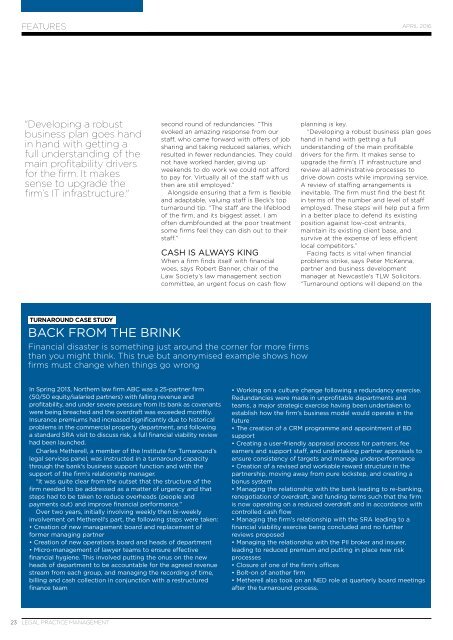LPM
LPM_APR_FINAL
LPM_APR_FINAL
Create successful ePaper yourself
Turn your PDF publications into a flip-book with our unique Google optimized e-Paper software.
FEATURES<br />
APRIL 2016<br />
"Developing a robust<br />
business plan goes hand<br />
in hand with getting a<br />
full understanding of the<br />
main profitability drivers<br />
for the firm. It makes<br />
sense to upgrade the<br />
firm’s IT infrastructure."<br />
second round of redundancies. “This<br />
evoked an amazing response from our<br />
staff, who came forward with offers of job<br />
sharing and taking reduced salaries, which<br />
resulted in fewer redundancies. They could<br />
not have worked harder, giving up<br />
weekends to do work we could not afford<br />
to pay for. Virtually all of the staff with us<br />
then are still employed.”<br />
Alongside ensuring that a firm is flexible<br />
and adaptable, valuing staff is Beck’s top<br />
turnaround tip. “The staff are the lifeblood<br />
of the firm, and its biggest asset. I am<br />
often dumbfounded at the poor treatment<br />
some firms feel they can dish out to their<br />
staff.”<br />
CASH IS ALWAYS KING<br />
When a firm finds itself with financial<br />
woes, says Robert Banner, chair of the<br />
Law Society’s law management section<br />
committee, an urgent focus on cash flow<br />
planning is key.<br />
“Developing a robust business plan goes<br />
hand in hand with getting a full<br />
understanding of the main profitable<br />
drivers for the firm. It makes sense to<br />
upgrade the firm’s IT infrastructure and<br />
review all administrative processes to<br />
drive down costs while improving service.<br />
A review of staffing arrangements is<br />
inevitable. The firm must find the best fit<br />
in terms of the number and level of staff<br />
employed. These steps will help put a firm<br />
in a better place to defend its existing<br />
position against low-cost entrants,<br />
maintain its existing client base, and<br />
survive at the expense of less efficient<br />
local competitors.”<br />
Facing facts is vital when financial<br />
problems strike, says Peter McKenna,<br />
partner and business development<br />
manager at Newcastle's TLW Solicitors.<br />
“Turnaround options will depend on the<br />
TURNAROUND CASE STUDY<br />
BACK FROM THE BRINK<br />
Financial disaster is something just around the corner for more firms<br />
than you might think. This true but anonymised example shows how<br />
firms must change when things go wrong<br />
In Spring 2013, Northern law firm ABC was a 25-partner firm<br />
(50/50 equity/salaried partners) with falling revenue and<br />
profitability, and under severe pressure from its bank as covenants<br />
were being breached and the overdraft was exceeded monthly.<br />
Insurance premiums had increased significantly due to historical<br />
problems in the commercial property department, and following<br />
a standard SRA visit to discuss risk, a full financial viability review<br />
had been launched.<br />
Charles Metherell, a member of the Institute for Turnaround’s<br />
legal services panel, was instructed in a turnaround capacity<br />
through the bank's business support function and with the<br />
support of the firm's relationship manager.<br />
“It was quite clear from the outset that the structure of the<br />
firm needed to be addressed as a matter of urgency and that<br />
steps had to be taken to reduce overheads (people and<br />
payments out) and improve financial performance.”<br />
Over two years, initially involving weekly then bi-weekly<br />
involvement on Metherell's part, the following steps were taken:<br />
• Creation of new management board and replacement of<br />
former managing partner<br />
• Creation of new operations board and heads of department<br />
• Micro-management of lawyer teams to ensure effective<br />
financial hygiene. This involved putting the onus on the new<br />
heads of department to be accountable for the agreed revenue<br />
stream from each group, and managing the recording of time,<br />
billing and cash collection in conjunction with a restructured<br />
finance team<br />
• Working on a culture change following a redundancy exercise.<br />
Redundancies were made in unprofitable departments and<br />
teams, a major strategic exercise having been undertaken to<br />
establish how the firm's business model would operate in the<br />
future<br />
• The creation of a CRM programme and appointment of BD<br />
support<br />
• Creating a user-friendly appraisal process for partners, fee<br />
earners and support staff, and undertaking partner appraisals to<br />
ensure consistency of targets and manage underperformance<br />
• Creation of a revised and workable reward structure in the<br />
partnership, moving away from pure lockstep, and creating a<br />
bonus system<br />
• Managing the relationship with the bank leading to re-banking,<br />
renegotiation of overdraft, and funding terms such that the firm<br />
is now operating on a reduced overdraft and in accordance with<br />
controlled cash flow<br />
• Managing the firm's relationship with the SRA leading to a<br />
financial viability exercise being concluded and no further<br />
reviews proposed<br />
• Managing the relationship with the PII broker and insurer,<br />
leading to reduced premium and putting in place new risk<br />
processes<br />
• Closure of one of the firm's offices<br />
• Bolt-on of another firm<br />
• Metherell also took on an NED role at quarterly board meetings<br />
after the turnaround process.<br />
23<br />
LEGAL PRACTICE MANAGEMENT


